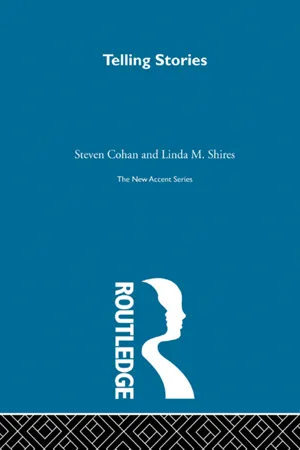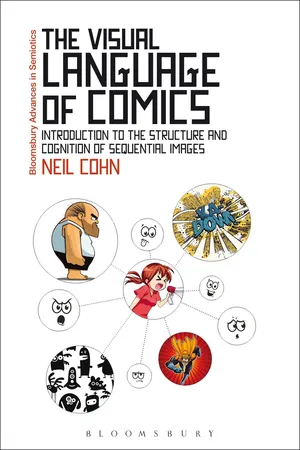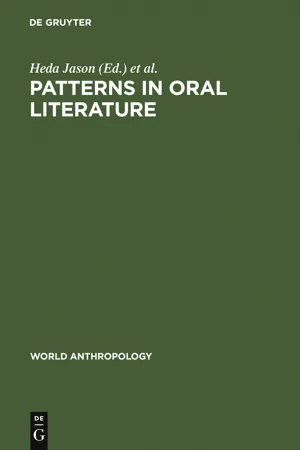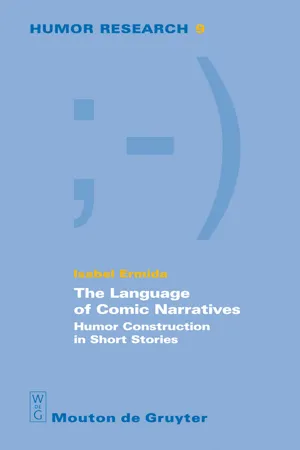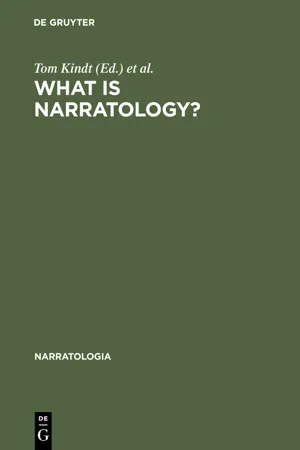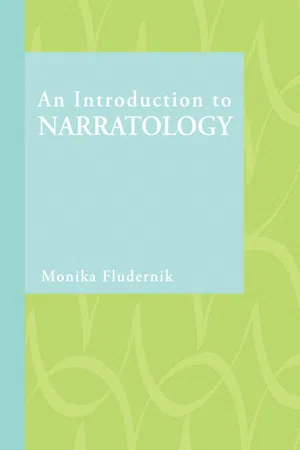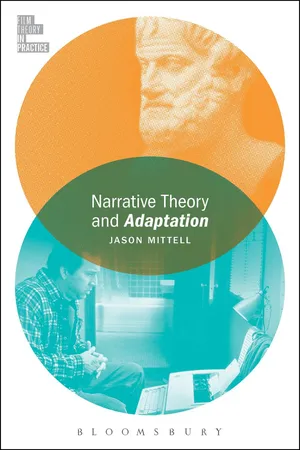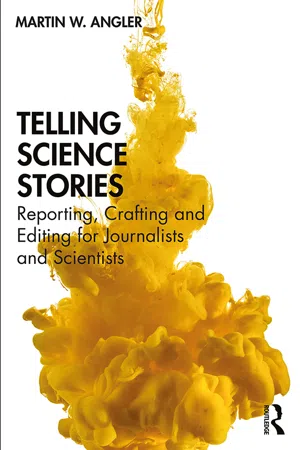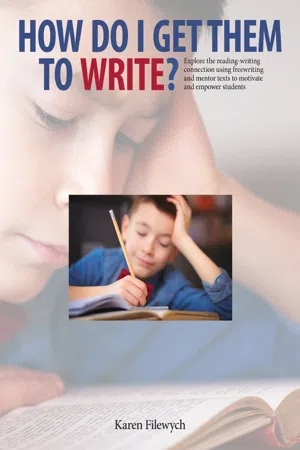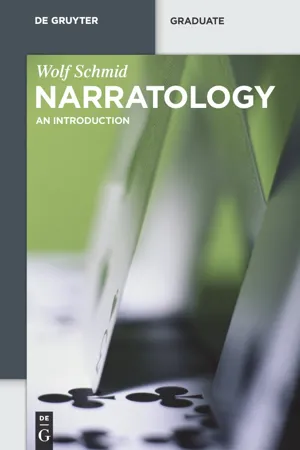Literature
Narrative Structure
Narrative structure refers to the organization and arrangement of events within a story. It encompasses the way in which a narrative is presented, including the sequence of events, the pacing, and the overall framework. This structure helps to shape the reader's experience and understanding of the story, and can vary widely across different literary works.
Written by Perlego with AI-assistance
Related key terms
1 of 5
12 Key excerpts on "Narrative Structure"
- eBook - ePub
- Steven Cohan, Linda M. Shires(Authors)
- 2013(Publication Date)
- Taylor & Francis(Publisher)
3 The structures of narrative: storyNarratives are always open to textual analysis because they consist of verbal and/or visual signs. In this chapter and the following one, however, we must temporally defer further discussion of textuality in order to show how narrative can also be analyzed as a signifying system in its own right. Together, these two chapters will examine how narrative organizes a field of signification and what kinds of signifying units it places in that field.The structural principles of similarity, placement, and difference organize “narrativity,” that is, a field of signification in which the familiar narrative units of story, character, temporal order, focalization, and so on, all function as signs in the same way that words and images do. A given narrative can be segmented, broken down for purposes of analysis. And, as in our discussion of textuality in chapter 2 , our analysis of narrativity here will seek to identify the most “stress-full” points of emphasis, pressure, and strain organized by its structure. To be sure, the narrative system often appears totally to determine a given text’s meaning by containing the play of narrativity within a closed structure, thereby centering it through a story or point of view; as we shall explain, however, a Narrative Structure cannot fully guarantee or exhaust meaning any more than a metaphoric one can.The distinguishing feature of narrative is its linear organization of events into a story. But a story has to do with more than just the organization of events. A journalist, for instance, follows a story (the events being covered) and also files a story (the account of those events). How and which events get narrated are therefore as important as – indeed, inseparable from – the way in which they occur. Accordingly, our examination of narrative will concentrate, in this chapter, on the organization of events, for which we reserve the term story, and, in the next chapter, on the organization of their telling, for which we use the term narration.1 - eBook - PDF
The Visual Language of Comics
Introduction to the Structure and Cognition of Sequential Images.
- Neil Cohn(Author)
- 2013(Publication Date)
- Bloomsbury Academic(Publisher)
The sixth trait deals with how structure interacts with meaning, and in fact many approaches to visual narrative have focused on the generation of inferences (e.g. Bordwell, 1985, 2007; Chatman, 1978; Eisenstein, 1942; McCloud, 1993; Saraceni, 2000). In this chapter, I will discuss only some aspects of inferences; further details will appear in future work. 70 THE VISUAL LANGUAGE OF COMICS Basic narrative categories As discussed at the outset, the function of Narrative Structure is to order meanings. Observations about a global narrative schema have a long-standing tradition in analyses of plot lines and storytelling, particularly for theatre. Over 2,000 years ago, Aristotle described the Beginning-Middle-End schema for plays (Butcher, 1902); in the thirteenth century, Zeami Motokiyo described a similar structure for Japanese Noh drama (Yamazaki, 1984); and in the nineteenth century, Gustav Freytag (1894) outlined the contemporary notion of a narrative arc for five-act plays. More recently, the idea of a canonical narrative schema emerged as central to theories of “story grammars” (Mandler and Johnson, 1977; Rumelhart, 1975; Stein and Glenn, 1979; Thorndyke, 1977). While “storytelling” is certainly a prototypical case, “narrative struc-tures” here are simply a method of packaging and presenting concepts , and, as such, they should be applicable beyond just “stories” (which may be an “entertaining” context of narrative broadly). In this context, “stories” are only a prototypical instance of Narrative Structure, and “good stories” are only a case of rhetorical skill. - eBook - PDF
- Heda Jason, Dimitri Segal, Heda Jason, Dimitri Segal(Authors)
- 2011(Publication Date)
- De Gruyter Mouton(Publisher)
A Model for Narrative Structure in Oral Literature HEDA JASON 1.1. The structure of oral literature can be divided into several levels: a. Wording — the language material with which linguistics deals. b. Texture — the organization of the wording. This is the proper domain of poetics: prosodic features of prose and verse of any order, the style of a genre, a culture, or a school of narrators and singers, and the individual idiosyncratic style of the performer (Lord's 1960 investigation is the classic example of texture investigation). c. Narration — the organization of the narrative's plot. In our paper this level will be discussed, along the lines of the Russian formalistic school. d. Dramatization—the organization of the performance: acoustic, visual, and kinetic aspects which are constituent elements of every performance of a work of oral literature, however short it may be (see Jason 1969, 1976: Chapter 11). These levels of structural organization are interconnected to various degrees. When the investigation started, it seemed that narrative and textural structure were independent of each other, and had to be considered separately. The narrative can be translated into another language and even into another medium of communication, such as a play or movie, and still keep its structure. Recently, with more and more detailed analysis, this separation of levels does not appear to be so absolute. On the surface level of the narrative, be it in prose or in verse, the Narrative Structure appears enmeshed in the arrangement of the My thanks go to both Mrs. Dafna Shmuelof who patiently helped in adapting and arranging the many examples for the paper, and to the Ethnological Museum and Folklore Archives in Haifa (IFA) which have, as always, most kindly put their manuscripts at my disposal. The translation of texts into English was done by the author, where not indicated otherwise. 1 0 0 HEDA JASON wording (see the examples which are all given verbatim). - eBook - PDF
The Language of Comic Narratives
Humor Construction in Short Stories
- Isabel Ermida(Author)
- 2008(Publication Date)
- De Gruyter Mouton(Publisher)
The humorous narrative text involves, as we shall see, a set Structure, model and whole 115 of observable structural features to be assessed in the concrete textual object. At the same time, however, these features also hint at the contextual way in which the author’s and the reader’s intentionality is construed. 2. Structure, model and whole The concept of structure in narratology has oscillated between two clearly dis-tinct theoretical stances, namely an operational conception and an ontological one (Reis and Lopes 2000: 146). On the one hand, structure is a synonym for model , an abstract product resulting from a comparison between several phe-nomena, whose heuristic value lies in its capacity to represent a set of universal characteristics and combinatorial rules. On the other, the term ‘structure’ is seen from an organic perspective, designating an ordered whole , a concrete object describable in terms of units and relations. The classical trend within structural narrative analysis sides with the former of these stances. Indeed, such authors as Barthes, Bremond and Larivaille seek, in a rather ambitious vein, to devise the ‘universal narrative language’, while overtly ignoring the concrete text. In other words, they attempt at uncovering recurrences and regularities between texts that point to universal algorithms and abstract models. The resulting formulation of narrative categories, rules and syntaxes aims at revealing the deep logic that underlies the syntactic organization of the text. This operational goal also partly underlies the present work (one of whose guiding questions is, roughly, “What are the constants of the humorous narrative?”). But the latter – and, in my opinion, complementary – stance outlined above, namely the ontological/organic approach, also obtains in the present analysis. - eBook - PDF
What Is Narratology?
Questions and Answers Regarding the Status of a Theory
- Tom Kindt, Hans-Harald Müller, Tom Kindt, Hans-Harald Müller(Authors)
- 2008(Publication Date)
- De Gruyter(Publisher)
They should really have been taken further and improved if necessary; instead, we had to wait for the Narratology Research Group Hamburg to perform the service of returning them and their potential benefits to the discourse of literary theory. As, however, they are doubtless still no more than partially remembered elsewhere, we shall now recapitulate the basic features of some key positions. The question of what a Narrative Structure actually is and what possible alternative Narrative Structures there might be was investigated using a wide variety of approaches. Because they dealt with the question at dif-ferent levels of abstraction and took different levels of the text as their ba-12 See, among others, Renner (1983); Titzmann (2003). 188 Michael Titzmann sis, these approaches were not mutually exclusive. Here, we shall con-sider four such variants of a theory of Narrative Structures. The first two are outlined in brief; the last two are described in greater depth because I believe they are more relevant to the theory and practice of interpretation. 1. Claude Bremond' 3 attempted to answer the question at the level of a theory of actions. He argued that texts with Narrative Structure are those texts in which actions are narrated, and that every narrated action can be described as a complex process of assembling possibilities in the text and selecting from, or choosing between, these paradigmatic alternatives. Dif-ferent kinds of action can be grouped into different classes of action on the basis of the particular context involved and by referring to the per-spectives of the characters concerned. These action classes correspond to the classification of the characters involved in the actions as the bearers of action roles. 2. Julien Algirdas Greimas 14 took as his starting point a semiotic square derived from logic. The terms of the square can have different se-mantic values in each text. - eBook - PDF
- S. Keen(Author)
- 2003(Publication Date)
- Palgrave Macmillan(Publisher)
Authors from Homer to Toni Morrison have exploited the techniques of disordering at the level of discourse. It makes sense to con- sider how the form or sectioning of the discourse might play a role in Shapes of Narrative: A Whole of Parts 17 shaping readers’ experiences of the story, and in recording the traces of the narrative’s making and publication, its individual literary history. One matter of terminology that must be confronted directly is the differ- ence between the structuralist sense of story explored in the preceding paragraph, and the commonsense usage of story to indicate a narrative fiction significantly shorter than a novel. None of the five definitions of ‘story’ in Gerald Prince’s Dictionary of Narratology acknowledges the primary meaning for most readers and writers, the sense invoked in a phrase such as ‘John Cheever’s story “The Enormous Radio”.’ Since ‘tale’ is an inexact synonym for ‘story,’ invoking as it does a set of generic associations with folk or fairy tales, substitution of terms does not solve the problem. It may be helpful to know that in structuralist efforts to systematize the elements of narrative, the distinction between long narratives (novels) and short ones (stories and tales) is usually collapsed, in the interest of arriving at a universal grammar of Narrative Structure. This is one of the reasons (though not the only one) that structuralist or post-structuralist critics refer to their objects of study as ‘texts.’ 1 To the working fiction writer who creates both stories and novels, this conflation obscures a world of vital differences. Although the minimalist short short story of barely a paragraph and the 900-page novel share many traits, their radically different lengths condi- tion the way they are written, read, criticized, and theorized. - eBook - ePub
- Monika Fludernik(Author)
- 2009(Publication Date)
- Routledge(Publisher)
Nevertheless, chapter divisions in novels are not used in a totally consistent way. The majority of chapter breaks are pragmatically motivated: they divide long stretches of narrative into more easily digestible morsels. Some authors, especially nineteenth-century ones, are particularly adept at chapter management. As a result of the serial publication of their works in periodicals, writers such as Charles Dickens were obliged always to end their instalments on a note of suspense, develop each and every strand of the plot in each episode and structure each instalment quite unmistakably as a sequence of three to four chapters.Structuring elements resembling chapters are also to be found within films, and not only in early productions which actually signalled a change of scene by means of written messages to the audience (‘Ten years later’ or ‘Meanwhile, back at the ranch’). To the best of my knowledge, this aspect has been somewhat neglected in film studies. In the meantime, a similar kind of structuring is quite clearly noticeable in films made for television because these have to take commercial breaks into account, the element of suspense clearly playing an important part in deciding where and when the breaks are to occur. With DVDs, moreover, films are divided into scene sequences and in some cases these are given individual titles. In theatre performances, visual markers (curtain, music, shifting of props) indicate scene and act changes. (But not always: in plays with multi-scene acts, the interval or intervals will tend to superimpose their structure on the five acts.)Text–internal Narrative StructuresNarrative levelsTo begin with, a distinction has to be made between various levels of narrative. Thus, in accordance with the well-known communicative model of narrative (A. Nünning 1989, Coste 1989, Sell 2000), there is a level at which the narrator (that is to say a narrator who is constituted in the text) communicates with a narratee. This level of narration or narrative communication can be either implicit or explicit. For instance, in Lilian Faschingers’s Magdalena the Sinner (Magdalena Sünderin - eBook - ePub
Translation and Conflict
A narrative account
- Mona Baker(Author)
- 2018(Publication Date)
- Routledge(Publisher)
Like most scholars in linguistics and pragmatics, having defined narrative as only one way of recapitulating experience, Labov goes on to focus on oral narratives and on their structural make-up. He elaborates a structural framework that divides these orally delivered stories into six components: abstract, orientation, complicating action, evaluation, result or resolution, and coda (1972: 362ff.). The components are all assumed to be realized in the form of clauses. For example, the abstract occurs at the beginning of the narration and consists of ‘one or two clauses summarizing the whole story’ (1972: 363); the orientation can occur ‘in the course of the first several narrative clauses, but more commonly there is an orientation section composed of free clauses’ (1972: 364); and so on. In its exclusive attention to oral narratives, its treatment of narrative as an optional mode of communication, and its preoccupation with the structural make-up of stories, this approach is very different from the one I intend to adopt in this book and which I attempt to elaborate in some detail in this chapter. Narration is the context for interpreting and assessing all communication – not a mode of discourse laid on by a creator’s deliberate choice but the shape of knowledge as we first apprehend it. (Fisher 1987: 193) In social and communication theory, as well as in the work of some historians such as Hayden White, narrative tends on the whole to be treated as the principal and inescapable mode by which we experience the world. Thus, Somers argues that ‘it is through narrativity that we come to know, understand, and make sense of the social world, and it is through narratives and narrativity that we constitute our social identities’ (1992: 600) - eBook - PDF
- Jason Mittell(Author)
- 2017(Publication Date)
- Bloomsbury Academic(Publisher)
McKee emphasizes that films reveal characters by what they do, via actions witnessed on-screen, rather than through inner monologues or soliloquies, devices more common to literature and theater respectively. In fact, we often know more about characters through their actions than their claims about themselves, which are often masks of self-denial and rationalization. Thus any distinction between events and characters is somewhat of an analytic convenience, as we cannot truly experience an action without the people involved in it, nor characters without the things that they do. Most of these aspects of practical narrative theory focus more on story rather than narrative discourse, highlighting what happens to whom in a film rather than how the film communicates that story to viewers. Plot structure is a by-product of both story and discourse, as the pacing of an inciting incident and narrative climax is dependent on the pacing of discourse time, rather than the experiential chronology of the NARRATIVE THEORY 21 storyworld—the filmmakers must choose which moments to portray or skip within the discourse, even though the characters experience much more over the course of the story, and those experiences rarely match the timing of a film’s act structure. These decisions of inclusion or exclusion, portrayal or omission, all impact not only the pacing and rhythm of a story and its ability to adhere to the ideal act structure of conventional films, but also the balance of knowledge between characters and audiences. Every film contains gaps between what viewers know and what various characters do, and these gaps are established by the narrative discourse. We are rarely inside the heads of characters, and even when we do hear their thoughts, we lack the wide range of memories and story experiences that occurred offscreen. - eBook - ePub
Telling Science Stories
Reporting, Crafting and Editing for Journalists and Scientists
- Martin W. Angler(Author)
- 2020(Publication Date)
- Routledge(Publisher)
Indeed, most representations of story structures manifest as two-dimensional line graphs of sorts, where one axis is time and the other one is tension or action (like Freytag’s and Hart’s). The planner then distributes plot points on that axis. That’s it. Plotting and outlining is all about selection and ordering. And rejection. Investigations practically never result in short pieces. In his book Story-based Inquiry (freely available, just Google it), investigative journalist Mark Lee Hunter details how to come up with an appropriate narrative at the end of an extensive investigative journalism project. You can structure your narrative in two ways. First, use a picaresque structure to order events by place, with the characters moving across those places over time. Homer’s Odyssey is an example of this structure. On a more contemporary note, Michael Moore tends to use that sort of structure in his documentaries (Hunter 2011). I can’t help but think of James Bond movies when I read about this structure. Hunter doesn’t really draw his structures as story shapes. If he did, he’d have probably a third axis: tension, time (the regulars) and place. Hunter’s second type of narrative sounds familiar: it’s the chronological structure, which you should use when ordering your events by time. Ultimately, it’s the material you gathered during the reporting that will determine which structure is the best for your story, but “one of these forms is right for your story” (Hunter 2011:66). Here is a short recipe on how to structure narratives. Begin with a moment that hooks the audience. Start in the present, go back in time to show how we got there (past), then bring it all the way back to the present moment (this will allow the readers to absorb the story), and then say where the story is headed to next (the future). As for chronological stories, Hunter advises to not continuously hop back and forward in time, as this confuses the readers - eBook - PDF
How Do I Get Them to Write?
Explore the reading-writing connection using freewriting and mentor texts to motivate and empower students
- Karen Filewych(Author)
- 2017(Publication Date)
- Pembroke(Publisher)
Now I cannot imagine teaching narratives any other way. In addition to teaching this concept, I also focus on four other important elements of narrative stories: (1) Narrative Structure, (2) dialogue, (3) character development, and (4) setting. Narrative Structure: Beginning, Middle, and End For students in junior high school or high school, we teach a fairly complex ver-sion of Narrative Structure with a focus on rising action, the climax, and falling action which ultimately leads to a resolution. In elementary school, I tend to focus on Narrative Structure more simply by using the terminology of beginning , middle , and end . Teaching students about plot patterns will help to ensure that they include a beginning, middle, and end in their stories. The plot patterns have an inherent structure that students follow, but creating a full Narrative Structure still requires practice. To help students develop strong story plots that include a beginning, a middle, and an end, I have them plan and tell stories orally. Using Wordless Picture Books I begin by showing them a wordless picture book. First, we go through the pages as a class observing the pictures without saying anything. The second time through, I model the telling of the story on each page. Of course, my oral story is my interpretation of the pictures. An interesting option is to have a student use 66 Narrative Writing the same book to tell a different version of the story. Students can then be given wordless books and work in partners to practise telling oral stories. These wordless picture books have another purpose in my classroom: I often choose one picture from a wordless picture book as a picture prompt to inspire student stories. In fact, in Alberta, Grade 6 students are required to write a story each spring based on a picture prompt provided on the Provincial Achievement Test . - eBook - PDF
- Wolf Schmid, Alexander Starritt(Authors)
- 2010(Publication Date)
- De Gruyter(Publisher)
(Friedemann 1910, 26) Many theories of the more recent past have continued to describe the dis-tinctive nature of narrative in terms of a mediation process. Franz Stanzel, for example, begins his Theory of Narrative (Stanzel 1979; tr. 1984), in which he summarizes his earlier works (Stanzel 1955, 1964) against the back-ground of new theoretical horizons, by reaffirming mediacy ( Mittelbarkeit ) as the defining characteristic of narrative texts. He thereby renews the status 2 I. Features of narrative in fiction of a property that he had previously invoked as the indispensable defining feature of narration in the introduction to his Narrative Situations in the Novel (Stanzel 1955; tr. 1971). The second concept of narrativity was developed in the structuralist study of narrative, for which Tzvetan Todorov (1969) coined the term nar-ratology . In structuralism, the defining characteristic of narrative is not a fea-ture of discourse or communication but rather a feature of what is narrated. Texts that we describe as narrative in the structuralist sense of the word contrast with descriptive texts in that they contain a temporal structure and represent changes of state. The classical concept restricts narrativity to the domain of verbal com-munication, covering only those works containing a narrating authority, or mediator, including purely descriptive sketches and travel reports, while ex-cluding all lyric, dramatic, and cinematic texts. The structuralist concept, on the other hand, can apply to a representation in any medium, but excludes representations whose referents do not have a temporal structure and con-sequently do not contain any changes of state. Thus, drama and lyric poetry are also narrative, in so far as changes of state are portrayed in them.
Index pages curate the most relevant extracts from our library of academic textbooks. They’ve been created using an in-house natural language model (NLM), each adding context and meaning to key research topics.
